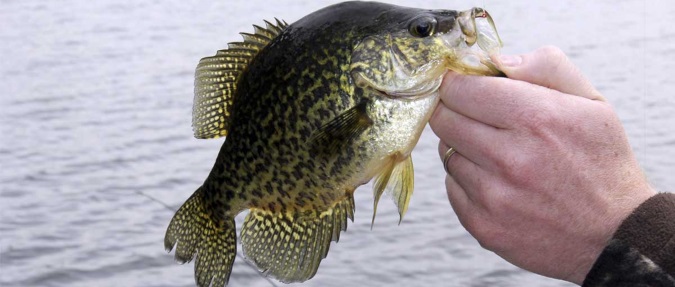
There’s a reason that sunfish (and some other freshwater fish) are often referred to as “panfish.” It’s because they often fit pretty well going into a pan—and usually taste pretty good coming out of one.
Unless, of course, you have my cooking skills.
But, my (lack of) culinary talents aside, one of the best tasting of Virginia’s multitude of freshwater fish is the black crappie, a member of the sunfish family and found in any number of lakes and rivers in the Commonwealth.
According to the Virginia Department of Game and Inland Fisheries (DGIF), one of the best places to find this tasty fish is the tidal portions of the Chickahominy River, which runs east from Hanover and Henrico counties and enters the James River around Jamestown.
Now, of course, we all know that the Chickahominy is one of the premier fisheries in the state for largemouth bass. But it’s also one of the country’s top tidal river fisheries overall, home to a variety of species—including black crappie.
DGIF biologists say that while black crappie numbers can vary a lot from year to year in the tidal portion of the Chickahominy River, anglers have reported good numbers of crappie in recent years.
Fishery experts say that black crappies—which feed on minnows, nymphs, crustaceans and insects—are among the top catches in the Chickahominy. Indeed, a large portion of the population will grow to 10 inches or more in length.
Beware: You may need a bigger pan for your catch.
While Pomoxis nigromaculatus—the scientific name for the black crappie—can be caught throughout the year, a particularly good time is early-March to mid-April when waters warm and the fish start to spawn.
According DGIF, “light spinning or spin-casting rods and reels with tiny jigs, doll flies, streamers, small crank baits that imitate minnows, small spoons and spinner-bucktail combinations, and spinner-grubs. Best live baits are small to medium minnows.”
While a bit more challenging, black crappie can also be caught on fly tackle as well, using bait fish imitations such as green or black wooly buggers. A nymph under a floating indicator will also often bring a hook-up.
The shoreline and man-made (e.g., docks) and natural structure (e.g., brush piles or downfalls) are good choices for locating black crappie. A watercraft will also help target the shoreline, especially grass lines and creek mouths.
If you find a school of black crappie, before you know it, you could land your limit!
Crappie (and other sunfish, of course) are great fish to get a new angler, especially a young person, started on. They’re aggressive and being bigger than most other sunfish, they can put up a decent fight.
As we all know, once someone catches their first fish, they’re usually “hooked.” (Pun intended.)
Indeed, with a limit of 25 fish per day, chasing black crappie this spring and summer on the Chickahominy River is a great way to build a relationship with a friend or a child—as well as develop your pan frying skills.
Dr. Peter Brookes is a part-time Virginia outdoor writer with a full-time job in Washington, D.C. in foreign policy.
By Peter Brookes, Virginia FW – https://www.dgif.virginia.gov/blog/crazy-for-crappie/?utm_source=mailchimp&utm_medium=email&utm_campaign=nftf&utm_content=nftf_fishing_february2019
Related articles:
